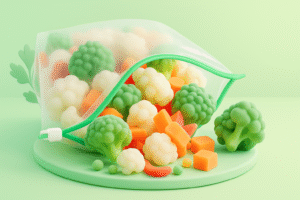The frozen veggies business has been expanding fast over the last few years, mainly because people are becoming more and more aware of the health benefits, convenience, and long shelf life of such products.
With the demand going up, the supply side (companies) has to keep up with the changes in the market, which is getting more and more digital.
If companies want to be successful, they have to use online sales, search engine optimization, and social media platforms to get more customers, retain existing ones, and thereby increase online sales.
The Role of E-commerce in the Frozen Vegetables Market
E-commerce platforms are the backbone of modern businesses’ success. They offer an easy, customer-friendly, and expandable method to expose products to a large number of customers.
The frozen vegetables market is also following the trend, as companies are more and more using online stores to deliver their products straight to the customers.
In addition to being a handy method of purchasing, e-commerce is a strong instrument in tearing down the barrier of distance, as it enables clients from various places to buy top-notch frozen vegetables.
Key Considerations for E-commerce in the Frozen Vegetables Market:
1. Platform Selection
The initial step in implementing e-commerce for the sale of frozen vegetables is selecting the appropriate platform.
Big e-commerce platforms such as Amazon, Walmart, and eBay offer wide consumer access and assistance with logistics.
But a lot of businesses also find it profitable to create their own websites or collaborate with niche marketplaces that are specially designed for food products.
The benefit of this method is more control of branding, customer experience, and product presentation.
2. Effective Product Listings
Product listings of a high standard are the main factor in e-commerce, as more than 60% of consumers are described and influenced by visuals.
In the case of frozen vegetables, it is very important to have clear images, correct descriptions, and detailed product information.
Point out the attributes of the product like freshness, organic certifications, and the convenience, for instance, frozen organic peas harvested at the time of the greatest freshness and frozen within a few hours to keep the nutrients.
3. Payment Options and Delivery
One of the main points that a business can improve its conversion rates is to have a checkout process without any inconveniences with the customer.
Offering various payment methods like credit cards, digital wallets, and Buy Now, Pay Later (BNPL) options will satisfy a variety of customers’ preferences.
In addition, because frozen vegetables are temperature-sensitive, it is very important to make sure that the delivery services are not only reliable but also efficient.
Allowing consumers to benefit from free or inexpensive shipping when purchasing in large quantities can also be a great way to attract them.
4. Customer Reviews and Trust Signals
Customer reviews and ratings are the major factors that guide online shoppers to make correct purchasing decisions.
If customers are motivated to give their opinion after finishing their purchase, it will become a trust-building strategy that will result in more sales.
If you answer quickly to the questions of your customers and help them out if they have any complaints or problems, it will be a confirmation to your customers that you are a seller they can trust.
Harnessing the Power of SEO for Online Frozen Vegetable Sales
SEO is necessary for companies operating in the frozen vegetables market to get higher positions in search engine results and bring non-paid traffic to e-commerce platforms.
The higher a brand is visible, the more it can turn the store visitors into buyers.
Key Strategies for SEO Success in the Frozen Vegetables Market
1. Keyword Research
Understanding the needs of prospective clients is definitely the primary step of any SEO strategy.
Keyword research is basically figuring out the exact words and phrases that people type to search on the console if they are looking to buy frozen vegetables online.
It could be a question like where to buy frozen peas, what frozen vegetables are best for a stir fry, or organic frozen veggies, and this should be searched on the tools, such as Google Keyword Planner, SEMrush, and Ahrefs are instrumental in coming up with the most searched-for keywords related to frozen vegetables.
2. On-Page Optimization
On-page SEO is the practice of adjusting content on individual web pages to achieve a higher ranking.
As an example, it is done on the pages of frozen vegetable products by making the titles, headings, meta descriptions, and images more friendly.
Every product page has to be full of the right keywords, not only in the text but also in the image alt tags.
A title for a frozen vegetable product may be something like Frozen Organic Carrots 1kg Pack is Rich in Vitamin A, and a description with keywords that emphasize the benefits.
3. Content Marketing
One of the main methods that a company can use to get a higher ranking in the search engines and to attract the attention of potential customers is by producing high-quality content of high quality.
Publishing content such as blogs, recipes, and informational guides revolving around frozen vegetables will bring in search engine traffic.
In this case, an article called “10 Quick and Healthy Meals Using Frozen Vegetables” would have the double effect of informing the purchasers about how versatile your products are, while at the same time enhancing your search rankings.
4. Mobile Optimization
A large portion of online shopping is done via mobile devices, which entails that an e-commerce site has to be exceptionally easy to use for mobile users.
Check that the site works well with various screen sizes and that the mobile version is simple and user-friendly.
Some of the aspects that should be taken care of are fast loading of the website, product pictures being mobile-friendly, and user-friendly checkout options being available.
5. Backlink Building
Backlinks or links from other websites to your site are one of the most significant elements of SEO.
If a website is getting quality backlinks from dependable and authoritative websites in the food, nutrition, and health sectors, then its domain authority and search ranking can be raised to a great extent.
A company could achieve this by having a food blogger, influencer, or an industry magazine come to do a product feature, share a recipe, or write an article about the business.
Leveraging Social Media Platforms to Drive Frozen Vegetable Sales
Compared with other methods, it would be nearly impossible to find better ways of contacting the target audience and increasing the brand’s awareness than through social media platforms.
With the help of such visually-oriented platforms as Instagram, Pinterest, and Facebook, the frozen vegetables industry appears to be an ideal candidate for social media marketing.
By means of innovative content, the companies have the potential to interact with customers, offer them various cooking ideas, and advertise their discounts.
Key Strategies for Social Media Success
1. Visual Content Creation
Since frozen vegetables are a consumable, the visual content is the main factor that can draw the consumer’s attention.
Pictures and videos of great quality that show the freshness, the use, and the convenience of frozen vegetables can attract.
A brand is able to establish a direct relationship with its consumers in one of the ways by sharing recipe tutorials, giving cooking tips, and showing attractive food photos.
For example, a brief Instagram video demonstrating the preparation of a fast stir-fry with the use of frozen mixed vegetables may attract those who are willing to purchase the product.
2. Engagement and Community Building
It’s not only about posting messages that social media is about, but it is also about establishing relationships with the target customers.
Reacting with followers via comments, polls, and direct messages is one way to put your brand on a human level and, therefore, to create a loyal community.
Sponsoring a contest or a challenge, such as asking followers to share their favorite frozen vegetable recipes, can, besides engagement, also increase brand awareness.
3. Influencer Partnerships
Associating with food bloggers or influencers who concentrate on healthy eating, cooking, or meal planning is a powerful tool in the promotion of frozen vegetables.
The content generated by these influencers using your products gets the most attention because it is considered real and friendly, hence drawing in their followers.
This greatly increases the influencer’s outreach and trustworthiness. The most important thing is to pick influencers whose followers are your potential customers.
4. Targeted Advertising
Social media platforms such as Facebook, Instagram, and TikTok come with great advertising capabilities that enable you to reach a particular audience by their demographic data, interests, and activities.
The usage of paid ads to promote special offers, new products, or seasonal sales is an excellent method to attract more people to your store and thus increase your turnover
5. Hashtags and Trends
Hashtags are one of the essential means of social media marketing through which new customers can easily locate content.
Firstly, learn what the trending hashtags are for frozen vegetables or healthy eating, and then incorporate them in your posts so that your posts can be visible.
The users who are looking for simple and healthy food solutions may become followers of the posts if hashtags such as #FrozenVeggies, #HealthyEating, or #QuickMeals are used.
Integrating E-commerce, SEO, and Social Media for Maximum Impact
Through the combined use of e-commerce, SEO, and social media strategies, companies operating in the frozen vegetable market can significantly increase their online sales.
These channels have restricted capabilities; however, when they are combined, they create a full digital marketing ecosystem that attracts traffic and increases customer engagement, and ultimately results in higher sales.
1. Omnichannel Approach
Social media could be used to bring visitors to your e-commerce site. At the same time, you need to be sure that your product listings are search engine-friendly.
For instance, a carefully designed social media post can have a link to your e-commerce store, where consumers can conveniently buy frozen vegetables.
In the same way, well-ranking blog posts in search engines can be the source of new visitors to your site who then could proceed with a purchase.
2. Data Analysis and Optimization
Continuously monitor the performance of the three channels that you have chosen. Use analytics tools to track the traffic, conversions, and engagement, and make decisions on the basis of this data about how to adjust the strategies.
For instance, if a certain recipe post is getting a lot of engagement on Instagram, you may want to promote it as a paid ad or feature it on your site.
According to Pristine Market Insights, to maximize online sales in the frozen vegetable market, a company has to employ a variety of strategies.
Through the usage of online shopping platforms, executing excellent SEO practices, and getting help from social media communication businesses can obtain more people visiting their websites, engaging customers, and finally, increasing the sales volume.
Knowing the consumers, producing quality content, and regularly updating the strategies by looking at the data will make your brand sustainable in a tough market.
Businesses aiming to maintain their position in the fast-changing frozen vegetables market need to change and come up with new ideas. If, by any chance, a company uses these three tools, e-commerce, SEO, and social media correctly, it will be able to raise its visibility on the web.







